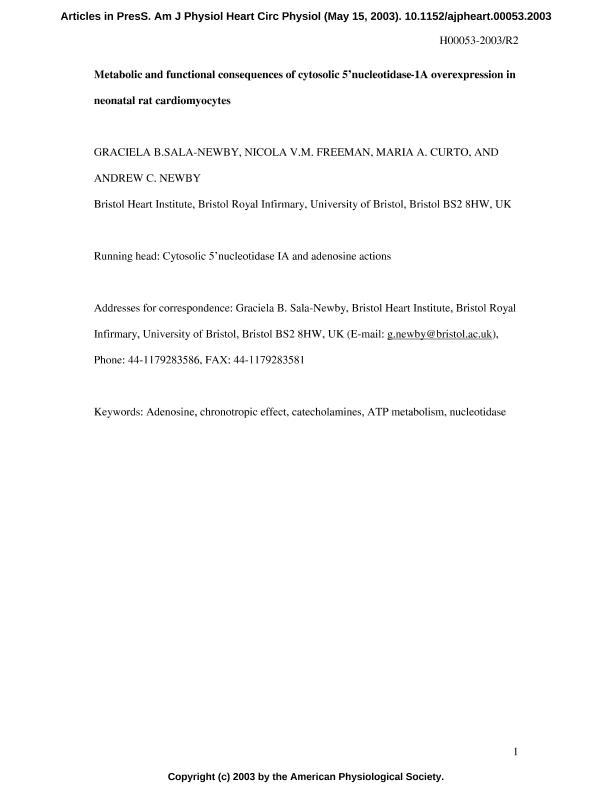Artículo
Metabolic and functional consequences of cytosolic 5′-nucleotidase-IA overexpression in neonatal rat cardiomyocytes
Fecha de publicación:
09/2003
Editorial:
American Physiological Society
Revista:
American Journal of Physiology - Heart and Circulatory Physiology
ISSN:
0363-6135
Idioma:
Inglés
Tipo de recurso:
Artículo publicado
Clasificación temática:
Resumen
Adenosine exerts a spectrum of energy-preserving actions on the heart negative chronotropic effects. The pathways leading to adenosine formation have remained controversial. In particular, although cytosolic 5′-nucleotidases can catalyze adenosine formation in cardiomyocytes, their contribution to the actions of adenosine has not been documented previously. We recently cloned two closely related AMP-preferring cytosolic 5′-nucleotidases (cN-IA and -IB); the A form predominates in the heart. In this study, we overexpressed pigeon cN-IA in neonatal rat cardiomyocytes using an adenovirus. cN-IA overexpression increased adenosine formation and release into the medium caused by simulated hypoxia and by isoproterenol in the absence and presence of inhibitors of adenosine metabolism. Adenosine release was not affected by an ecto-5′-nucleotidase inhibitor, α,β-methylene-ADP, but was affected by a nucleoside transporter, dipyridamole. The positive chronotropic effect of isoproterenol (130 ±3 vs. 100 ±4 beats/min) was inhibited (107 ±3 vs. 94 ±3 beats/min) in cells overexpressing cN-IA, and this was reversed by the addition of the adenosine receptor antagonist 8-(p-sulfophenyl)theophilline (120 ± 3 vs. 90 ± 4 beats/min). Our results demonstrate that overexpressed cN-IA can be sufficiently active in cardiomyocytes to generate physiologically effective concentrations of adenosine at its receptors.
Palabras clave:
Adenosine
,
Chronotropic Effect
,
Catecholamines
,
Atp Metabolism
Archivos asociados
Licencia
Identificadores
Colecciones
Articulos(INGEBI)
Articulos de INST.DE INVEST.EN ING.GENETICA Y BIOL.MOLECULAR "DR. HECTOR N TORRES"
Articulos de INST.DE INVEST.EN ING.GENETICA Y BIOL.MOLECULAR "DR. HECTOR N TORRES"
Citación
Sala-Newby, Graciela B.; Freeman, Nicola V. E.; Curto, Maria de Los Angeles; Newby, Andrew C.; Metabolic and functional consequences of cytosolic 5′-nucleotidase-IA overexpression in neonatal rat cardiomyocytes; American Physiological Society; American Journal of Physiology - Heart and Circulatory Physiology; 285; 3; 9-2003; H991-H998
Compartir
Altmétricas




